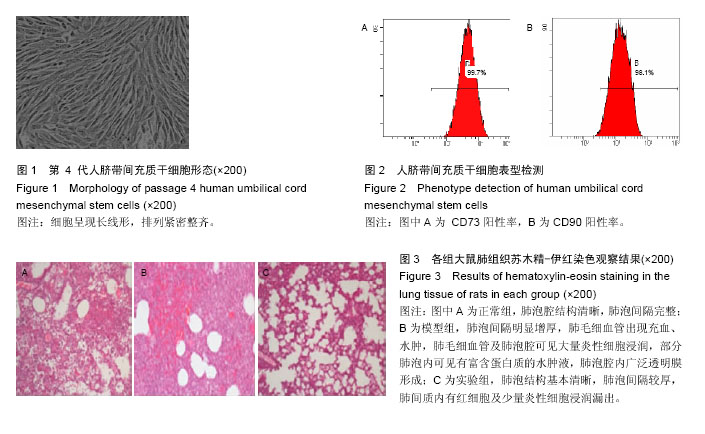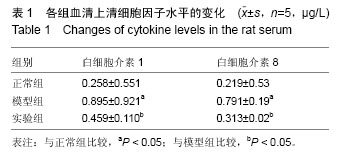| [1] 金发光.急性肺损伤的诊治研究现状及进展[J].中华肺部疾病杂志,2013,6(1):1-7.[2] Johnson ER,Matthay MA.Acute lung injury: epidemiology, pathogenesis, and treatment. J Aerosol Med Pulm Drug Deliv.2010;23(4):243-252.[3] Matthay MA,Zimmerman GA.Acute lung injury and the acute respiratory distress syndrome: four decades of inquiry into pathogenesis and rational management. Am J Respir Cell Mol Biol.2005;33(4):319-327.[4] 王佩贤.肺纤维化的中医临床研究概述[J].中华实用中西医杂志,2011,24(4):4-7.[5] Fan CG,Zhang QJ,Zhou JR.Therapeutic potentials of mesenchymal stem cells derived from human umbilical cord.Stem Cell Rev.2011;7(1):195-207.[6] Garcia O,Carraro G,Navarro S,et al.Cell-based therapies for lung disease.Br Med Bull. 2012;101(1): 147-161.[7] Woodbury D,Schwarz EJ,Prockop DJ,et al.Adult rat and human bone marrow stromal cells differentiate into neurons.J Neurosci Res.2000;61(4):364-370.[8] Ying QY, Nichols J,Evans EP,et al.Changing potency by spontaneous fusion.Nature. 2002;416(6880): 545-548.[9] 裴雪涛,王常勇,王冬梅,等.干细胞生物学[M].北京:科学出版社,2003:107-203.[10] 赵春华,艾辉胜,杜智,等.干细胞原理、技术与临床.[M].北京:化学工业出版社,2006:63-82.[11] 姜玉峰,李思源,慕晓玲.骨髓基质细胞成骨的研究进展[J].解剖学研究,2004,26(1): 69-71.[12] Reilly GC,Radin S,Chen AT,et al.Differential alkaline phosphatase responses of rat and human bone marrow derived mesenchymal stem cells to 45S5 bioactive glass.Biomaterials.2007;28:4091-4097.[13] Fehrer C,Lepperdinger G.Mesenchymal stem cell aging.Exp Gerontol.2005;40:926-930.[14] Glennie S,Soeiro I,Dyson PJ,et al.Bone marrow mesenchymal stem cells induce division arrest anergy of activated T cells.Blood.2005;105(7):2821-2827.[15] Moodley Y,Atienza D,Manuelpillai U,et al.Human umbilical cord mesenchymal stem cells reduce fibrosis of bleomycin-induced lung injury.Am J Pathol. 2009; 175(1):303-313.[16] Kotton DN,Ma BY,Cardoso WV,et al.Bone marrow-derived cells as progenitors of lung alveolar epithelium.Development.2001;128(24):5181-5188.[17] Sueblinvong V,Loi R,Eisenhauer PL,et al.Derivation of lung epithelium from human cord blood-derived mesenchymal stem cells.Am J Respir Crit Care Med. 2008;177(7):701-711.[18] Liu Y,Dulchavsky DS,Gao X,et al.Wound repair by bone marrow stromal cells through growth factor production.J Surg Res.2006;136(2):336-341.[19] McAnulty RJ.Fibroblasts and myofibroblasts: their source, function and role in disease.Int J Biochem Cell Biol.2007;39(4):666-671.[20] Boissel L,Tuncer HH,Betancur M,et al.Umbilical cord mesenchymal stem cells increase expansion of cord blood natural killer cells.Biol Blood Marrow Transplant. 2008;14(9):1031-1038.[21] Aggarwal S,Pittenger MF.Human mesenchymal stem cells modulate allogeneic immune cell responses. Blood.2005;105(4):1815-1822.[22] 刘慧莹.脐带间充质干细胞及气体治疗急性肺损伤的实验研究[D].军事医学科学院,2014.[23] Stagg J.Immune regulation by mesenchymal stem cells: two sides to the coin.Tissue Antigens. 2006; 69(1):1-9.[24] Xu J,Woods CR,Mora AL,et al.Prevention of endotoxin-induced systemic response by bone marrow-derived mesenchymal stem cells in mice.Am J Physiol Lung Cell Mol Physiol.2007;293(1):131-141.[25] Németh K,Leelahavanichkul A,Yuen PS,et al.Bone marrow stromal cells attenuate sepsis via prostaglandin E2–dependent reprogramming of host macrophages to increase their interleukin-10 production. Nat Med.2008;15(1):42-49.[26] Krasnodembskaya A,Song Y,Fang X,et al.Antibacterial effect of human mesenchymal stem cells is mediated in part from secretion of the antimicrobial peptide LL-37.Stem Cells.2010;28(12):2229-2238.[27] Chan JL,Tang KC,Patel AP,et al.Antigen-presenting property of mesenchymal stem cells occurs during a narrow window at low levels of interferon-γ. Blood. 2006;107(12):4817-4824.[28] Rasmusson I,Le Blanc K,Sundberg B,et al.Mesenchymal stem cells stimulate antibody secretion in human B cells.Scand J Immunol. 2007; 65(4):336-343.[29] Sueblinvong V,Loi R,Eisenhauer PL,et al.Derivation of lung epithelium from human cord blood–derived mesenchymal stem cells.Am J Respir Crit Care Med. 2008;177(7):701-711.[30] Popov BV,Serikov VB,Petrov NS,et al.Lung epithelial cells induce endodermal differentiation in mouse mesenchymal bone marrow stem cells by paracrine mechanism.Tissue Eng. 2007;13(10):2441-2450.[31] Rojas M,Xu J,Woods CR,et al.Bone marrow-derived mesenchymal stem cells in repair of the injured lung.Am J Respir Cell Mol Biol.2005;33(2):145-152.[32] Kotton DN,Fabian AJ,Mulligan RC.Failure of bone marrow to reconstitute lung epithelium.Am J Respir Cell Mol Biol.2005;33(4):328.[33] Loi R, Beckett T, Goncz KK, et al.Limited restoration of cystic fibrosis lung epithelium in vivo with adult bone marrow–derived cells.Am J Respir Crit Care Med.2006; 173(2):171-179.[34] Sheu CC,Gong MN,Zhai R,et al.Clinical characteristics and outcomes of sepsis-related vs non-sepsis-related ARDS.Chest.2010;13(8):449-467.[35] Hu X,Qian S,Xu F,,et al.Incidence, management and mortality of acute hypoxemic respiratory failure and acute respiratory distress syndrome from a prospective study of Chinese paediatric intensive care network. Acta Paediatr.2010;9(9):715-721.[36] Ware LB,Koyama T,Billheimer DD,et al.Prognostic and pathogenetic value of combining clinical and biochemical indices in patients with acute lung injury. Chest.2010;13(7):288-296.[37] Kim ES,Chang YS,Choi SJ,et al.Intratracheal transplantation of human umbilical cord blood-derived mesenchymal stem cells attenuates Escherichia coli-induced acute lung injury in mice.Respir Res.2011; 12:108.[38] Cribbs SK,Matthay MA,Martin GS.Stem cells in sepsis and acute lung injury.Crit Care Med.2010;3(8): 2379-2385.[39] Lee JW,Gupta N,Serikov V,et al.Potential application of mesenchymal stem cells in acute lung injury. Expert Opin Biol Ther.2009;9(1):1259-1270.[40] Matthay MA,Goolaerts A,Howard JP,et al. Mesenchymal stem cells for acute lung injury: preclinical evidence.Crit Care Med.2010;3(8): 8569-573. |
.jpg)


.jpg)